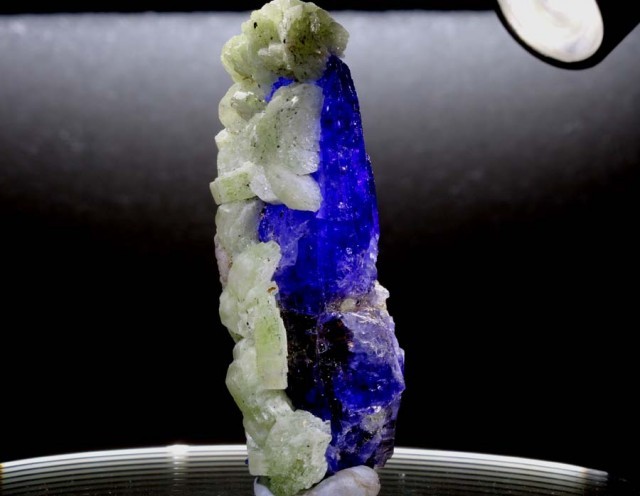CROCOITE AUSTRALIAN COLLECTOR SPECIMENT 166 CTS
- SKU
- spe
- Dimensiones (mm)
- 46 x 43 x 22mm
- Peso (cts)
- 165.999
- Treatment
- No Treatment
- Type
- Specimen
- Colores
-
CROCOITE -AUSTRALIA
SPECIMEN
BRIGHT HYACINTH -RED CRYSTAL ON MATRIX
TREATMENT-NONE
RARE COLLECTOR PC, NATURAL CLEAR CRYSTAL
WEIGHT : 166 CTS APPROX.
SIZE : 46 X 43 X 22MM APPROX
Crocoite is a mineral consisting of lead chromate, PbCrO4, and crystallizing in the monoclinic crystal system. It is sometimes used as a paint, being identical in composition with the artificial product chrome yellow. It was discovered at Berezovsky deposit near Ekaterinburg in the Urals in 1766; and named crocoise by F. S. Beudant in 1832, from the Greek κροκος, saffron, in allusion to its color, a name first altered to crocoisite and afterwards to crocoite. It is found as well-developed crystals, although these are usually poorly terminated. Crystals are of a bright hyacinth-red color, translucent, and have an adamantine to vitreous lustre. On exposure to light much of the translucency and brilliancy is lost. The streak is orange-yellow; Mohs hardness is 2.5–3; and the specific gravity is 6.0. In the Urals the crystals are found in quartz-veins traversing granite or gneiss. Other localities which have yielded good crystallized specimens are Congonhas do Campo near Ouro Preto in Brazil, Luzon in the Philippines, and Mutare in Mashonaland.
Gold is often found associated with this mineral. Exceptional examples of crocoite crystals have been found in the Adelaide Mine at Dundas, Tasmania; they are long slender prisms, 3 to 4 inches (7.5 to 10 cm) in length, with a brilliant lustre and color. Crocoite is also the official Tasmanian mineral emblem.
Associated with crocoite at Berezovsk are the similar minerals phoenicochroite and vauquelinite. The former is a basic lead chromate, Pb2CrO5, and the latter a lead and copper phosphate-chromate, Pb2CuCrO4PO4OH. Vauquelinite forms brown or green monoclinic crystals, and was named after L. N. Vauquelin, who in 1797 discovered (simultaneously with and independently of M. H. Klaproth) the element chromium in crocoite.
Relative rarity of crocoite is connected with specific conditions required for its formation: an oxidation zone of lead ore bed and presence of ultramafic rocks serving as the source of chromium (in chromite). Oxidation of Cr3+ into CrO42- (from chromite) and decomposition of galena (or other primary lead minerals) are required for crocoite formation.
| Proveedor de envío | Envío a Australia | Envíos al resto del mundo | Envío combinado ( Australia ) | Envío combinado (resto del mundo) |
|---|---|---|---|---|
| Standard Shipping - Tracked |
|
|
|
|
| FedEx |
|
|
|
|
| DHL |
|
|
No disponible |
|
- SKU
- spe
- Dimensiones (mm)
- 46 x 43 x 22 mm
- Peso (cts)
- 165.999
- Treatment
- No Treatment
- Type
- Specimen
- Colores
-
CROCOITE -AUSTRALIA
SPECIMEN
BRIGHT HYACINTH -RED CRYSTAL ON MATRIX
TREATMENT-NONE
RARE COLLECTOR PC, NATURAL CLEAR CRYSTAL
WEIGHT : 166 CTS APPROX.
SIZE : 46 X 43 X 22MM APPROX
Crocoite is a mineral consisting of lead chromate, PbCrO4, and crystallizing in the monoclinic crystal system. It is sometimes used as a paint, being identical in composition with the artificial product chrome yellow. It was discovered at Berezovsky deposit near Ekaterinburg in the Urals in 1766; and named crocoise by F. S. Beudant in 1832, from the Greek κροκος, saffron, in allusion to its color, a name first altered to crocoisite and afterwards to crocoite. It is found as well-developed crystals, although these are usually poorly terminated. Crystals are of a bright hyacinth-red color, translucent, and have an adamantine to vitreous lustre. On exposure to light much of the translucency and brilliancy is lost. The streak is orange-yellow; Mohs hardness is 2.5–3; and the specific gravity is 6.0. In the Urals the crystals are found in quartz-veins traversing granite or gneiss. Other localities which have yielded good crystallized specimens are Congonhas do Campo near Ouro Preto in Brazil, Luzon in the Philippines, and Mutare in Mashonaland.
Gold is often found associated with this mineral. Exceptional examples of crocoite crystals have been found in the Adelaide Mine at Dundas, Tasmania; they are long slender prisms, 3 to 4 inches (7.5 to 10 cm) in length, with a brilliant lustre and color. Crocoite is also the official Tasmanian mineral emblem.
Associated with crocoite at Berezovsk are the similar minerals phoenicochroite and vauquelinite. The former is a basic lead chromate, Pb2CrO5, and the latter a lead and copper phosphate-chromate, Pb2CuCrO4PO4OH. Vauquelinite forms brown or green monoclinic crystals, and was named after L. N. Vauquelin, who in 1797 discovered (simultaneously with and independently of M. H. Klaproth) the element chromium in crocoite.
Relative rarity of crocoite is connected with specific conditions required for its formation: an oxidation zone of lead ore bed and presence of ultramafic rocks serving as the source of chromium (in chromite). Oxidation of Cr3+ into CrO42- (from chromite) and decomposition of galena (or other primary lead minerals) are required for crocoite formation.
| Proveedor de envío | Envío a Australia | Envíos al resto del mundo | Envío combinado ( Australia ) | Envío combinado (resto del mundo) |
|---|---|---|---|---|
| Standard Shipping - Tracked |
|
|
|
|
| FedEx |
|
|
|
|
| DHL |
|
|
No disponible |
|

rare large gemstones and minerals.
-
 Positivo
PositivoAbsolutely stunning, incredible quality, fast shipping i am blown away by it thankyou so very much
-
 Positivo
PositivoPaid and shipped - no feedback left after 100 days
-
Positivo
This is the most beautiful Blue Zircon that I have ever seen. I know Zircon's very well, and this Blue Zircon is a premium gem and the correct color
-
 Positivo
PositivoPaid and shipped - no feedback left after 100 days
-
 Positivo
PositivoPaid and shipped - no feedback left after 100 days
















